A guide to SEO, content, and social for the beauty industry
Contents
- The importance of digital marketing in the cosmetics industry
- SEO for the cosmetics industry
- Content marketing for the beauty industry
- Social media marketing for the beauty industry
- Emerging makeup trends and opportunities
- Final thoughts
Intro
In a world where influencers share products and techniques on a global scale, things that were once only available to the rich and the famous now have increased exposure to everyday consumers.
Through digital channels like TikTok, Instagram, and YouTube, the latest beauty trends have never been more accessible to all, regardless of age, gender, location, or socio-economic status.
The UK’s beauty industry reached a jaw-dropping £27 billion net worth in 2022. It currently ranks as the seventh-largest global market and holds the third spot for the largest market operating in the UK.
With such a competitive market, many brands have tried to create a distinctive customer experience, increasing the chance of creating loyal customers. The strategy involves a combination of offline and online marketing.
However, there has been an ever-growing demand for online shopping after the pandemic, with more than 2.14 billion buyers shop digitally.
This impressive number is why most beauty brands are paying more attention to the beautiful world of digital marketing.
Let’s look at how digital marketing can be used in the beauty industry and how the audience plays a large part in how products are marketed.
The importance of digital marketing in the cosmetics industry
Digital marketing is essential for helping a business reach its target audience on a broader scale.
It helps to build brand awareness, drive sales, and allow your brand to engage with consumers.
Digital marketing allows beauty brands to reach their audience through various online channels.
These include social media platforms, search engines, and email marketing.
Creating and maintaining brand awareness in such a competitive industry is crucial.
Digital marketing helps brands establish and reinforce their identity through consistent messaging, engaging content, and visual appeal.
Compared to traditional marketing methods like televised or print advertisements, digital marketing is more cost-effective.
Digital marketing tactics like product linking, a brand can seamlessly blend with eCommerce platforms and enable customers to purchase directly from ads or social media posts.
This makes things simple for the customer, potentially increasing conversion rates.
Data and analytics are essential in digital marketing as they provide insight into the effectiveness of campaigns and what your customer wants.
This data-driven approach can be the key when optimising future strategies for better results.
As the cosmetics industry grows alongside technology, we expect consumers to rely even more heavily on digital platforms for beauty information and guidance when making purchases.
Target audience: Influencers, brands, and emerging trends
Digital marketing data can assist brands with the creation of targeted advertising by using demographic, behaviour, and interest-based data to provide customers with personalised content.
It’s essential to effectively utilise content marketing in the beauty industry to give users engaging and useful information across every platform and level of the marketing funnel.
Brands can create blogs, videos, and infographics to educate and inform their audience. They can also boost brand visibility through influencer collaborations, establishing a more varied audience through content marketing posted by others.
The cosmetics industry is incredibly fast-paced, with trends and consumer preferences constantly changing.
Digital marketing allows brands to easily adapt and creates room for modifying strategies to respond to market shifts.
Digital marketing can assist brands with targeted advertising, using information such as demographic, behaviour, and interest-based data to deliver personalised content. This data can also push advertisements to the right audience and increase your chances of conversions.
Throughout this piece, let’s explore the following
- The power of digital marketing within the cosmetic industry
- Highlight the importance of good SEO practices when you have a cosmetics business
- Outline effective keyword research and analysis for beauty products
- Explore the benefits of social media marketing
- Discuss on-page optimisation practices and how it can provide great user experience
- Outline off-page optimisation and the benefits
- Explore how good SEO practices can benefit your beauty business and ensure success.
SEO for the cosmetics industry
Understanding the importance of SEO in the beauty industry
Some cosmetic companies can have an excellent digital marketing strategy for social media platforms but fail to uphold good SEO practices.
Unfortunately, poor application of SEO tactics can make or break the customer experience.
The beauty industry is highly competitive, and effective SEO can give your brand that competitive edge and help you outrank competitors in the search results.
Effective SEO practices make it more likely for potential customers to find your products, in turn, increasing the chance of purchase.
SEO tools can provide valuable insights into customer behaviour and preferences. This data can be the foundation for your marketing strategies and allow your business to make data-driven decisions.
Beauty brands often produce a lot of content, including product descriptions, tutorials, blog posts, and user-generated content like reviews. You can use SEO practices to optimise this content, making it more accessible to search engines and increasing the chances of attracting organic traffic.
SEO allows your brand to target keywords and phrases relevant to your brand. When you target these keywords, you can attract genuine visitors to your site with a potential interest in purchasing.
Well-applied SEO also improves visibility and discoverability, as your beauty business is more likely to appear within search engine results pages (SERPs).
The better your SEO strategy and the higher quality of your content, the more likely you are to rank highly within SERPs, meaning your pages will push the users first.
High-ranking websites are deemed more trustworthy and credible by consumers, which is essential in the beauty industry, where consumers want to be confident in the products they purchase and the information they receive.
Local SEO is also vital if you have a business with a physical location such as a salon, spa, or makeup studio.
Optimising your site for local searches means your business is discoverable for local map listing and location-based search results, which can drive foot traffic and appointments for your services.
Keyword research and analysis for beauty products
Selecting the right keywords is essential for a successful online marketing strategy. The process shouldn’t be rushed — it requires plenty of time and dedication to find the perfect terms to push your brand to a better position and increase your online visibility.
Keyword research is incredibly important, so you must understand your target audience. Put yourself in your audience’s shoes and consider what phrases or words your customer might be searching for when looking for similar products.
Ask yourself:
- What is the target age group?
- Are they likely to use formal language or slang?
- What issue does my product resolve?
When you answer all these questions, you have a clearer idea of your customer preferences and can suggest how they might describe the product you provide to the search engine.
Identifying niche keywords
Identifying niche keywords provides a less competitive but more conversion-oriented way for your customers to discover your site.
These specific terms are often long-tail keywords — phrases containing three to five words on average, but they can be more.
Despite being less frequently searched for, these long-tail keywords can attract more targeted traffic of valuable users and provide a higher chance of conversion.
| Keywords | Monthly Average Search Volume |
| soap brows | 6,000 |
| brow soap | 2,500 |
| soap eyebrows | 690 |
| how to do soap eyebrows | 180 |
| can i do soap brows with any soap | 10 |
| how to get soap brows to stay | 10 |
In the beauty industry, niche or branded keywords can be identified when trends appear. For example, the hashtag ‘soap brows’ has 256.6 million views on TikTok at the time of writing, so we know it’s popular.
If we use this example to identify the long-tail keywords for this trend, ‘how to get soap brows to stay’, we can see it doesn’t have as much of a search volume as ‘soap brows’ on its own.
However, using this phrase appropriately can catch consumers who know what they want and are ready to buy, but have yet to make a purchase.
Incorporating these keywords into your product descriptions, articles, or blogs can be a fantastic way to draw in your customers and increase conversion rates.
Remember, all keywords selected should accurately represent your brand and specific products to attract the right users honestly.
It will start to pay off once you’ve invested time learning about your audiences and behaviours. Don’t forget, it’s not just your audience you need to watch — it’s your competitors, too!
Analysing competitor keyword strategies
Monitoring your competitors is an excellent benchmark for discovering SEO keywords for beauty and skincare products.
Review their sites and take notes of the language style they use in their content, including titles, meta descriptions, and product descriptions. These are where you’ll find their chosen keywords.
Some SEO tools like Ahrefs can be excellent for streamlining competitor and keyword research analysis, revealing the keywords other brands use and presenting their effectiveness based on ranking data.
For example, below is a comparison of three incredibly popular makeup sites. LOOKFANTASTIC, BEAUTY BAY, and Cult Beauty are all online beauty retailers that sell branded products, like an online supermarket. However, looking at the comparison, you can immediately tell which one of these sites isn’t using good SEO practices.
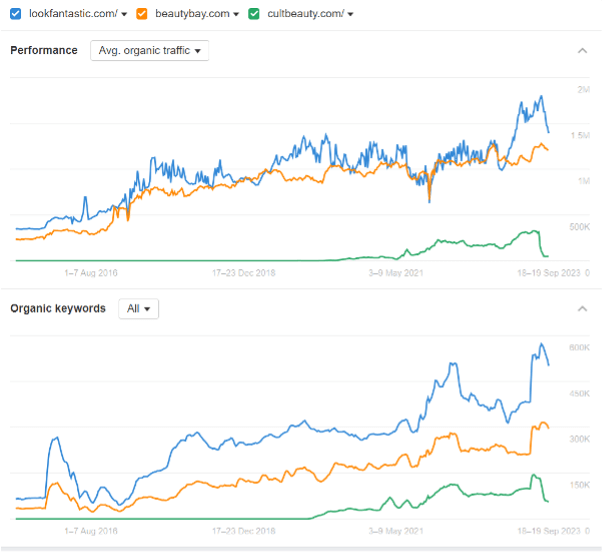
The average organic traffic for Cult Beauty is significantly lower than its counterparts. This highlights the potential for implementing a more robust SEO strategy and content marketing tactics.
On-page optimisation
On-page optimisation involves improving your webpage content to better meet the needs of users and search engines.
To improve your on-page SEO, you should optimise the page for search intent, title tags, internal links, and URLs.
Search engines like Google review the page’s content to decide if a page matches the user’s search intent and whether it will be useful to the user, and, as a result, whether it should be displayed higher in the search results.
Meta tags and title optimisation
Meta tags and title optimisations are great for helping to improve user experience as they can show search engines how relevant your page is to the user’s query.
Content optimisation
Content optimisation is the process of refining and enhancing digital content to improve its visibility, engagement, and effectiveness. The process involves:
- ensuring content quality, including keywords
- writing captivating titles and meta descriptions
- earning authoritative backlinks
Image optimisation
This is easy enough to follow. The key thing to remember is always to choose the right format. While many image formats exist, the PNG and JPEG are the most common for the web.
Off-page optimisation
Off-page optimisation includes link building, guest posting, social media marketing and gaining exposure through various platforms.
Building high-quality backlinks
Link building is an excellent tactic for getting other sites to link to your pages. These are also known as backlinks.
The more backlinks from high-authority site pages you have, the more ‘authoritative’ your site will seem to Google.
When link building, you always need to consider two key factors:
- Authority: This measurement of a website’s quality. Links from high-authority sites are more valuable and can help you rank higher.
- Unique domains: The number of separate domains (reference domains) that link to your site. Getting links from as many quality domains as possible should be a key focus in your strategy.
Guest blogging and collaborations
Influencer marketing is when brands work with popular bloggers and social media influencers as to promote products or services.
This is an incredible way to build your brand, reach new audiences, and ensure you’re present on multiple different platforms.
Local SEO strategies for physical stores
Local SEO enhances your content and online presence to increase local traffic, visibility, and brand awareness across a specific area.
Some elements of local SEO are off-page, such as Google Business Profile. This free business listing tool can help influence how your business is displayed on Google.
Optimizing your Google Business Profile is a crucial off-page SEO tactic. It’s an excellent tool to increase your site’s visibility in high-value positions on Google’s search results pages.
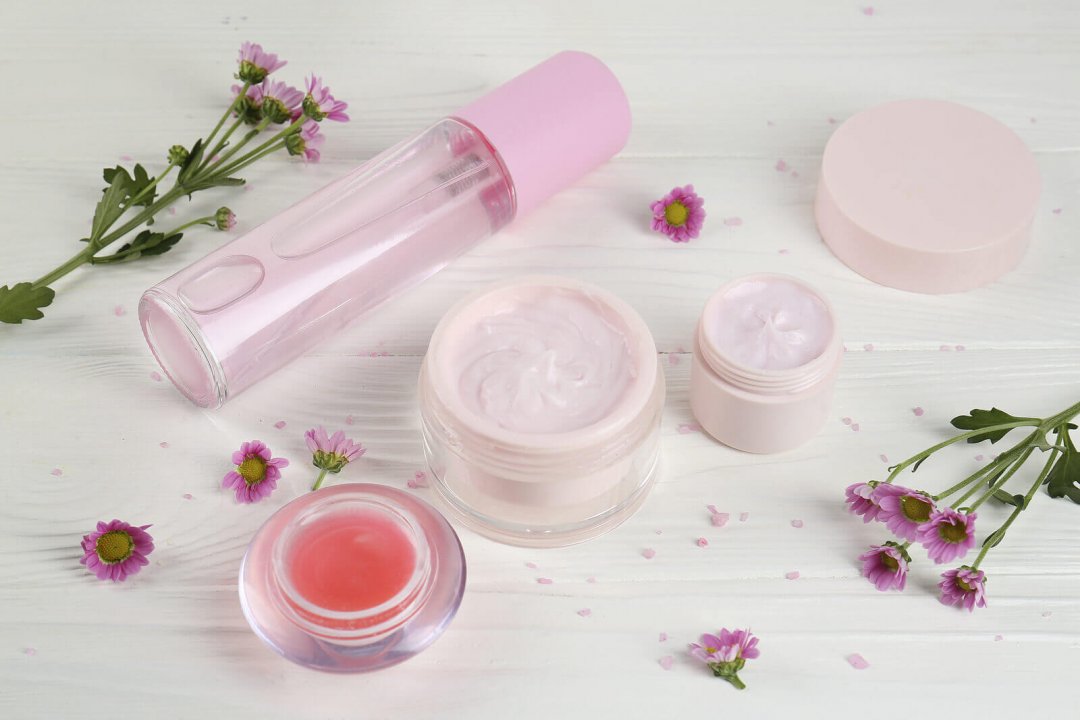
Monitoring SEO performance and making improvements
SEO performance is how well a website ranks in search engines, attracting organic traffic. However, there are many other useful ways to monitor SEO results.
- Organic traffic: The most accurate way to measure organic traffic is with Google Search Console through the ‘search result’ report. This can also be a great way to benchmark your com competitors.
- Keyword rankings: The position of your website’s utilised keywords in the SERP. The higher you rank, the more likely you are to drive traffic to your site. However, be aware that a website’s keyword rankings can change when Google updates its algorithm, you lose backlinks, or your competitors publish new content. Tracking your rankings is important to gauge why a page is underperforming.
- SERP visibility: Measures how often your website appears in search engines for relevant keywords.
- Click-Through Rate (CTR): The percentage of users who click on your site from the SERP. CTR can show how effective your title tags and meta descriptions are in attracting the attention and interest of searchers.
- Bounce rate: The percentage of users who visit your site but leave without any further interactions. This measures how engaging and relevant your content is for your visitors.
- Website authority: Predicts how well your website will rank in search engines. If you compare your authority score to your competitors, this can help you understand it better.
- Backlinks: Links from other sites that point to yours. Backlinks help highlight your site as trustworthy and valuable to others.
- Engagement time: Also known as time on page, this is the average time visitors spend on a page before leaving. When a user types a keyword in Google, reaches your page, and stays for some time, it suggests your site is what they were looking for.
These are just some things you can monitor regarding your SEO performance.
Remember, with SEO, it takes time to see results, and the timeline of success depends on how good your site is, how good your SEO strategy is, and the level of consistency you apply when implementing your strategies.
Another important factor to remember is the visibility and ranking of your website will be heavily influenced by who your competitors are and the keywords you are trying to rank for.
SEO is an excellent investment, but you must remember consistency is kept when following good SEO practices, and it’s gradual, so prioritise sustainability over speed.
Content marketing for the beauty industry
Defining content marketing goals
In the beauty industry, consumers constantly seek information that provides advice, tips, and product recommendations, which is when content marketing is incredibly effective.
As a beauty brand, there is a continuous timeline to create and distribute valuable, informative, and engaging content to attract and retain a customer base with the value you provide.
Identifying target audience personas
Identifying your target audience is essential to the success of your content. Ask yourself — are they searching for skin care? Is makeup their main interest? What price point are they comfortable with?
Try aligning your content with the audience’s interests to ensure you attract and retain the right users for your brand.
Certain factors are important to consider when identifying the target audience for your beauty brand.
- Age: Skin care products heavily focus on a user’s age and what treatments they will likely want. Products like anti-wrinkle creams are more likely to target a demographic of women over 35, while hormonal acnes products may be targeted at those under 25. Always ask what problem your product solves, and you’ll likely identify who your audience is.
- Interests: What is your audience interested in? Is it health and wellbeing or surface-level beauty products?
- Income level: Each demographic has a different income and budget. Consider the price of your products to determine which demographic your audience fits into.
- Language: The main language your audience speaks also ties into location and is based on where you want to target. It will also help you better curate content.
- Favourite websites: How does the audience spend their time online? Assess the content from these sites to help steer your tone in advertising.
- Buyer pain point: What is the user’s pain point, and can you help resolve it?
- Buyer behaviour: How do they buy? What kind of content drives them to act and make a purchase?
- Concerns: Is there anything your buyer is concerned about? How can you share that information to answer that question in advertising?
These are questions you should consider to identify your audience and align your brand with customer interests.
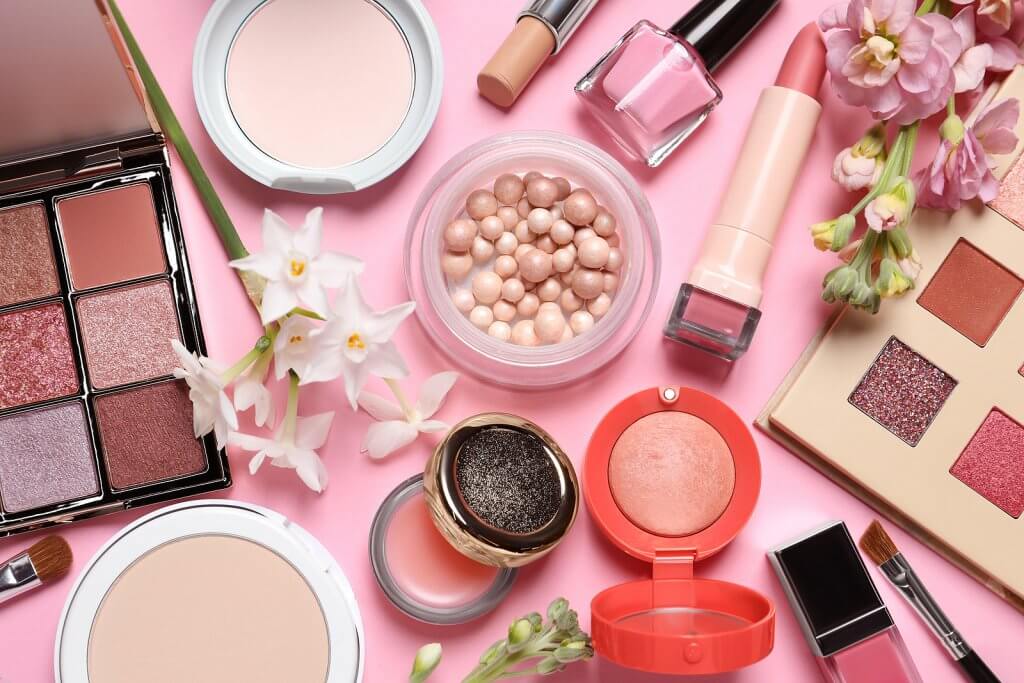
Types of content to make your brand glow
In digital marketing, there are no strict limitations to content formats. You can promote your brand or product in many ways through various content formats.
Content is known to be one of three main SEO search ranking factors, and if you get your content right, people will visit, stick around, and become regular customers of your brand.
1. Blog posts
Blog post content is easy to produce and, when done correctly, can help build your online authority within your industry.
They can be educational guides, top 10 lists, and even interview-based.
Create content that can be repurposed as other content formats and shared over socials.
2. Videos
Most audiences enjoy video content. It’s one of the most popular content formats of mobile users and is a trusted source for for many.
Video content is incredibly popular in the beauty industry, mainly thanks to step-by-step makeup tutorials, skincare routines, or hairstyling videos.
This format can provide great visibility when shared on TikTok, Instagram, and YouTube, and can also be an excellent contributor to business revenue.
3. Infographics
Infographics are widely shared online, so it’s essential to create attractive and informational graphics.
Make sure it carries exciting and reliable information the audience will want to share with their personal audience.
4. Podcasts
Podcasts are a great form of content to engage your audience in a way that works for them as they can access your content at their own convenience.
It’s also a great option for repurposing existing content.
If you’ve already created the video or blog, the audio could easily become a podcast and vice versa.
5. Webinars
Webinars, which are online seminars, are an excellent business content marketing format.
The usually involve a presentation and Q&A session.
Use them to show off your expertise and demonstrate your brand products and services, hopefully encouraging attendees to make a purchase.
Creating high-quality content
With so much content within the beauty industry driven by a consumer thirst for knowledge, it’s imperative your content is high-quality.
When you create educational content that informs your audience about important topics like skincare routines, makeup techniques, haircare tips, and product ingredients, your content can give your brand enhanced and respected authority within the industry.
1. Addressing pain points and providing solutions
Building trust and credibility with your target audience can be done through pain-point SEO.
When you focus your content on solving your audience’s problems, you automatically position yourself as an authority.
This approach will attract more qualified leads and make your brand attractive to business partners or investors.
2. Keeping up with emerging trends
In the beauty industry, it can sometimes feel like things change overnight with ever-changing trends, leaving you feeling out of step with your customers.
The best way to keep up-to-date and informed is to check on the trending topics and hashtags on social media.
Consistently reviewing search trends and emerging topics can also help keep you ahead.
3. Storytelling and connecting with the audience
Storytelling and connecting with the audience through social media platforms like Instagram, TikTok, and Pinterest, which are popular spaces for beauty-related content.
Share visually appealing images of behind-the-scenes content and engage with your audience by replying to comments and direct messages.
Promoting content through various channels
To ensure you make the most out of your content, you need to ensure you promote it. Content promotion can be done in various ways, such as through owned, paid, and earned media channels.
Owned media channels promote content through platforms you already have, such as a website, social media, email newsletter, or blog.
Paid media channels include PPC, social ads, and collaboration with influencers
Earned media channels are mentions, shares, forums, reviews, and guest posts.
All three ways of content promotion are essential to ensure you reach the right audience.
Measuring content marketing success
Before you start creating any content, it’s essential to carry an understanding of your target audience. Think about who you are targeting in the beauty industry.
Is it skincare enthusiasts, makeup lovers, or people searching for haircare tips? Awareness of your audience’s preferences and pain points will help you create content that resonates with your audience.
Here are some things you should consider when measuring your content marketing to be a success.
- User-generated content: This type of content helps to build trust with consumers and can create a sense of community around your brand. Repost user-generated content on your social media platforms or website and encourage all customers to share their experience of your brand or products.
- Content calendars: Content calendars are an excellent way to keep organised and ensure consistent content. You can also align your content with seasonal trends, exciting product launches, and other marketing campaigns.
- Analytic tools: These tools are essential when measuring the performance of your content marketing efforts. Monitor metrics like website traffic, engagement rates, conversion rates, and the growth in your social media followers to gauge your success.
- Feedback and improve: Listen to your customer feedback and improve or adapt your content strategy as needed. If you notice that certain content performs better, focus on producing more of that variety.
- Social media engagement: Ensure you remain active on all social media platforms. Instagram, Facebook, and TikTok are popular for beauty-related content. Share images and behind-the-scenes content and engage with your followers.
The critical thing to remember when promoting your content through these channels is that consistency and authority are essential.
Customers are constantly looking for trustworthy information and solutions to their beauty concerns.
Providing reliable content can build up a loyal customer base and make your brand stand out in such a competitive market.
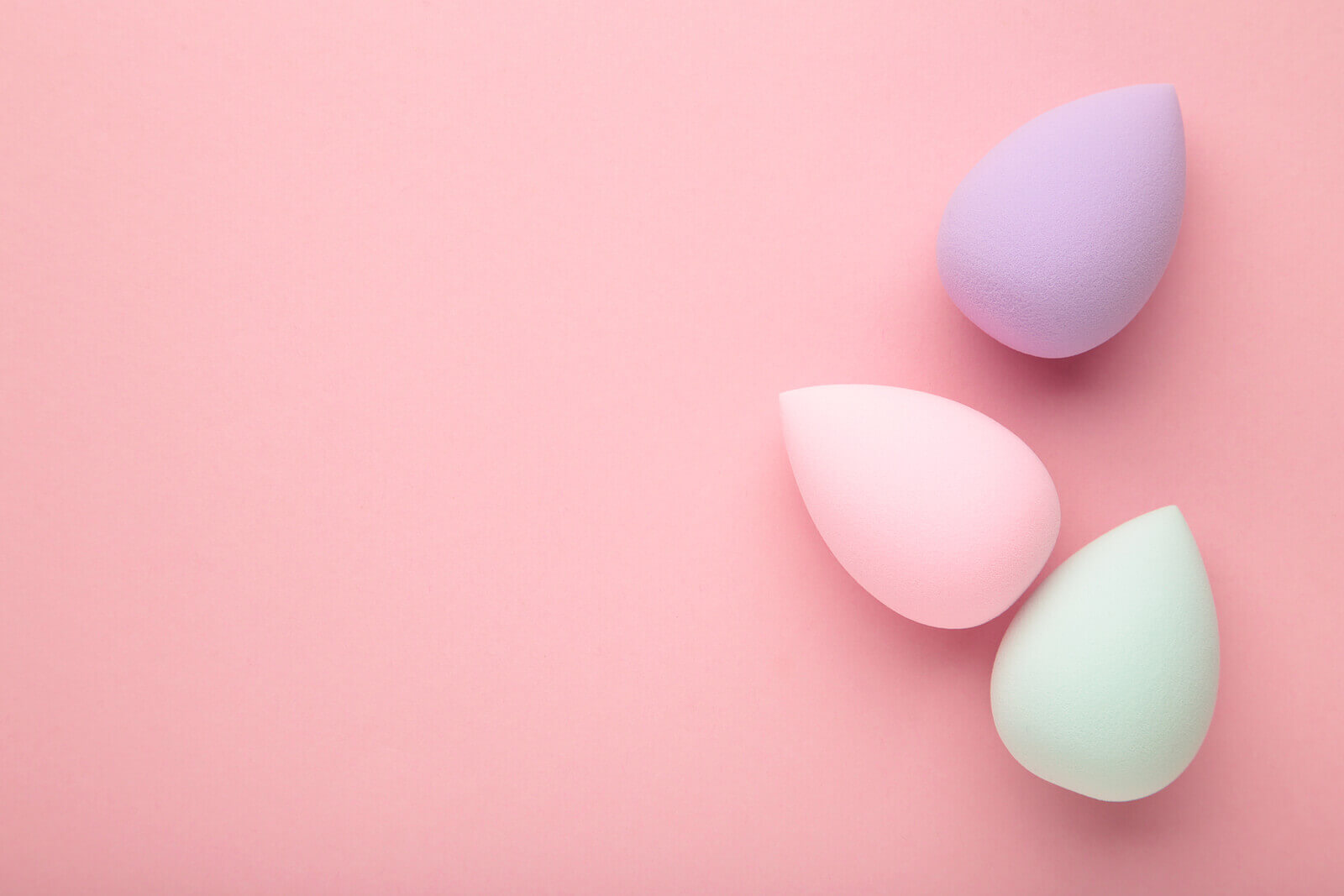
Social media marketing for the beauty industry
The cosmetics industry is highly visual, and social media provides a perfect platform for showcasing your products.
Platforms like Instagram and TikTok are perfect for brands to share high-quality content and highlight the aesthetic appeal of your product, making it easier for customers to see what they’re buying.
According to Google, 85% of shoppers find product information and pictures are essential when deciding which retailer or brand to purchase from.
Having product information and pictures is good SEO practice, but having quality content across your site and social media channels may give the customer that extra push to purchase.
Importance of social media in cosmetics marketing
Beauty brands were among the first to believe in the power of social influence and prioritise it in marketing strategies.
Many consumers scroll social media sites searching for inspiration, whether from close influencers or brands they follow.
Beauty hashtags on Instagram have amassed 535 million entries, and content creators, not brands, made 86% of the top beauty videos on YouTube.
With so many consumers trusting influencers over brands, it makes sense for beauty brands to collab with influencers who like and use their products.
Choosing the right platforms
Break down your social platforms like they are individual audiences.
The number of users and their age brackets can vary widely across platforms, and it helps to understand those brackets and tailor each platform to its unique audience.
Consider who your audience is and which platforms they interact with the most to understand better what content to create.
1. Instagram
Users in the UK spend around 53 minutes a day on Instagram. It’s a huge platform that can provide incredible exposure for your brand.
For example, beauty brand Kylie Cosmetics has over 25.5 million followers, while high-end-brand Anastasia Beverley Hills has 19.5 million and Fenty Beauty 10.9 million.
Although these big brands are your competition, this can benchmark consumer interest.
We know that Instagram is mostly used by users aged 25 to 34, so you should aim to tailor your platform content to that particular audience segment.
2. Facebook
Facebook is an incredibly popular social media platform with 1.62 Billion users.
Facebook groups are proving a potent tool for beauty brands. Your loyal customers are likely to follow you on Facebook groups and pages to keep up-to-date on the latest trends, new products, and upcoming deals.
Share events and promotional posts on Facebook to keep your audience connected to your brand.
3. Pinterest
Pinterest is a platform that boasts 465 million users. Content on Pinterest aims to inspire users with visual imagery and is where consumers browse, discover, and buy products directly through links.
It can be the perfect place to reach that part of your audience who engages with example pictures.
4. YouTube
YouTube plays a large role in helping consumers make purchase decisions, both online and offline.
In 2018, beauty content on YouTube had a mesmerizing 169 billion views, and this number will increase as YouTube continues to grow.
Creators on YouTube have vast and loyal followings and opinions that many trust.
Even if your brand isn’t creating its own content. YouTube is the perfect platform for content influencer collaborations.
5. TikTok
TikTok has currently been noted as the fastest-growing social media app in the world and has over 1-billion monthly active users.
As a platform, it offers an excellent opportunity to build a large organic audience for your brand.
TikTok is excellent for brand and product promotions and has even launched an in-app shop, making it even easier for customers to purchase products.
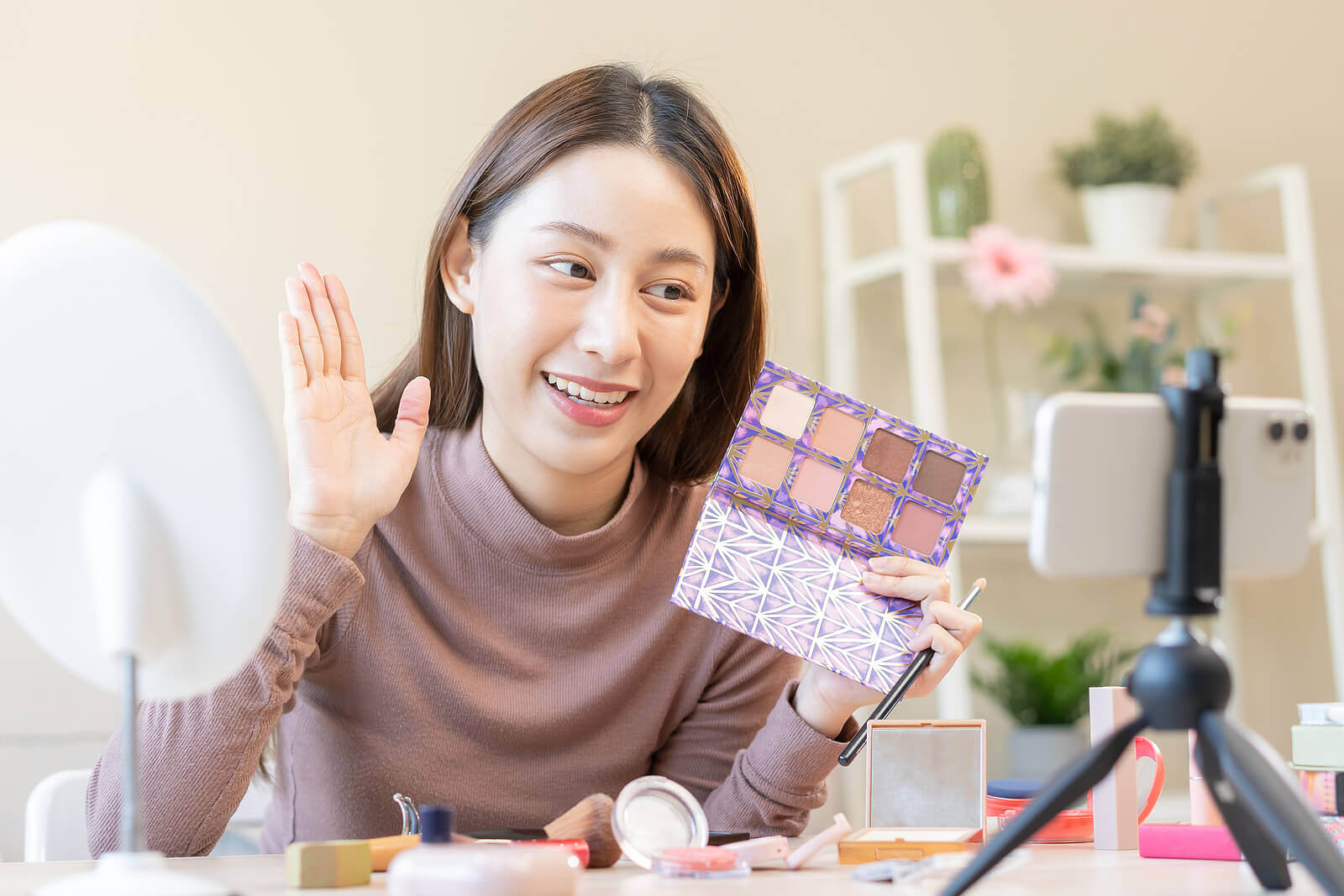
Building and engaging with a community
Social media platforms provide an ideal space for brands to engage with customers through likes, comments, shares, and direct messaging. This style of engagement builds customer loyalty and long-lasting relationships.
Here are some things to consider when building your community
- Welcome your customers: Invite those you already know and currently do business with to like or follow your account, having space for fresh customer relationships, too.
- Use hashtags: Hashtags are an excellent way to build an organic following, making you more discoverable for those searching for those tags.
- Call to action (CTA): Add a CTA to your company website to encourage visitors to follow your social media pages.
- Respond: If your audience feels they are being spoken at and not engaged with, they may assume your brand doesn’t care about customer needs. Respond to what they’re saying in a way they will feel appreciated.
- Use GIFs, emojis, quote images, and memes: When building a community, use these to fit into the social media space.
- Develop consistent voice: Develop an authentic brand voice with a clear tone.
- Be responsive: Responsiveness is critical. Followers of your social media pages should know you care about feedback and aren’t simply on social media for promotion.
- Engage with your followers: Engagement is key to ensuring your followers feel appreciated and will feel happy to interact with your platform.
- Recurring topics: Post series on a weekly or monthly basis will give your fans something to look forward to and keep them engaged.
Influencer marketing and collaborations
Collaborating with influencers can be a game changer for your market reach. Celebrities or influencers with a large following can bring credibility and attention to your product and brand.
Influencer marketing carries many benefits, including:
- increased brand awareness
- access to a wider audience
- increased engagement and interaction
- cost-effective marketing strategy
- potential to reach a new demographic.
Collaborating with influencers with a large following can improve ROI and higher conversion rates.
If the influencer is popular and highly rates your product, it also increases the potential to go viral and allows you to reach a wider audience.
Social media advertising
Social media is a pillar in digital marketing, and social media advertising is a type of marketing where you can use paid media to promote your beauty products or business.
It’s available in multiple formats and carries a range of creative promotions ranging from images to video experiences.
1. Targeting options
When deciding who to target, use your existing customer data, as it can help pave the way for further success. Do some market research and look at analytics from existing platforms.
This will help you gauge an idea of what might work well.
Each platform will help you target different customers based on demographics, interests, and behaviours, enabling you to retarget certain audiences.
More than 3.25 billion active social media users access social networks from mobile devices, so you must ensure all ads are tailored for mobile viewing.
2. Creating compelling ads
When creating compelling ads, you need to remember your initial goal.
Focus on the unique selling position of your product or service — by doing so, you already have an advantage over your competitors, giving your advertising more value.
Connect with your target audience to be sure your product or service will be appealing and be more successful.
Choose the right channel for your ads to make sure you get the results you’re hoping for.
3. Measuring success and optimizing campaigns
A great benefit of social media ads is that they can provide instant feedback.
The effectiveness of a sponsored post can be seen within minutes and followed up with analytical reports.
Consider your initial campaign goals to work out what worked well and what didn’t.
Measuring your results and having solid data showing the value ads bring to your company is a key part of providing detailed return on investment (ROI).
Utilizing user-generated content and testimonials
Social media is a direct way to receive feedback from your customers.
This provides valuable insights about customer preferences, pain points, and suggestions to influence product development and marketing strategies.
User-generated content is a great tool to help influence engagement and increase conversions.
The customer-centric content can then be shared across other channels, including email, landing pages or checkout pages.
Emerging makeup trends and opportunities
2023 brings in a post-pandemic chapter for beauty brands to navigate and shape.
As consumer preferences and beauty standards evolve, beauty brands can capitalise on makeup trends to meet the demands of consumers in an ever-changing market.
There has been an increased interest in minimalistic and natural-looking makeup looks.
Some consumers are embracing their natural features rather than heavy makeup looks we have seen in previous years.
An opportunity here would be to offer makeup products that cater to this particular trend, such as sheer foundations, tinted moisturisers, and nude-toned lip kits.
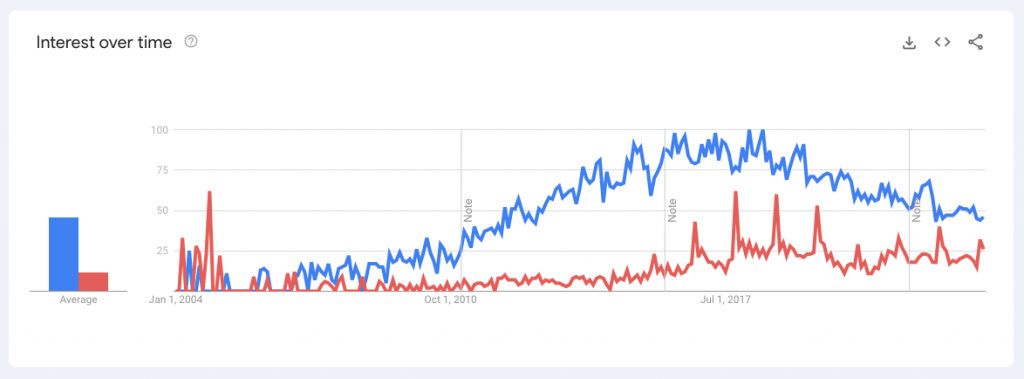
Using Google trends, we can see the three main products of mascara, lipstick, and eyeliner follow the same pattern of search trends.
However, lipstick and mascara products are less invasive than eyeliner, and so are more likely to be used to create a more natural makeup look.
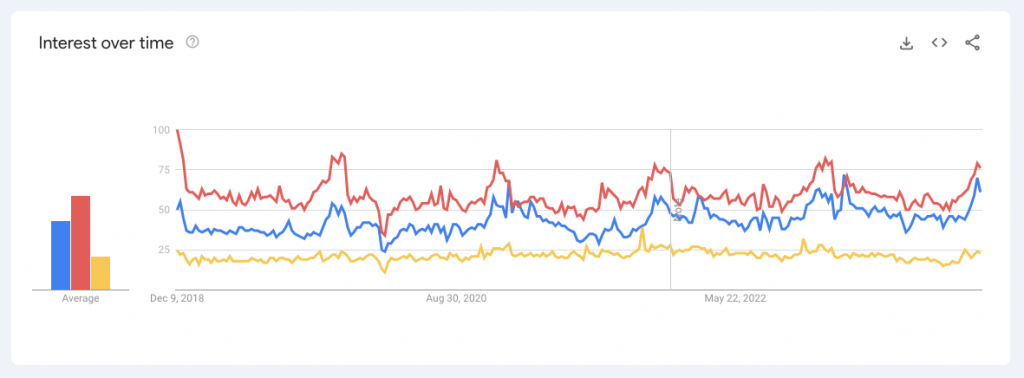
Keeping an eye on industry trends
Staying up-to-date on everything related to your product or brand is a requirement of the industry. To ensure success in the beauty industry, enhanced knowledge is what will separate you from your competitors.
If you aren’t consistently researching and learning about the beauty industry, it may lead you to fall behind, miss out on new customers, or lose existing customers to emerging brand favourites.
In today’s online world, one of your greatest attributes can be email. Stay subscribed to a source you trust and allow yourself to read, review, and stay current.
Sites such as thetrendspotter can be excellent sources for staying in the know.
Capitalizing on new product opportunities
Capitalizing on new product opportunities in the beauty industry can be an excellent way to boost your product or brand visibility.
Stay updated to know the latest beauty trends and emerging technology, understanding how they can be used to your advantage.
Benchmark your competitors to help you understand their products and how to market them, highlighting opportunity gaps.
You can also email your customers to gather insights about their beauty needs and preferences and conduct small-scale market testing to gauge your product’s attractiveness.
Invite focus groups, product samples, or limited releases to specific markets.
Success within the beauty industry takes time and persistence, and you should remain committed to delivering high-quality content and products that will cater to the ever-evolving needs of your desired target audience.
Adapting marketing strategies to fit trends
Adapting marketing strategies to fit trends in the beauty industry requires a deep understanding of what your consumers want.
Stay informed. Trends constantly change, and it pays to be updated with the latest. Keep yourself informed by following beauty influencers and celebrities to see what products they endorse.
Develop and modify your products to be innovative in line with the current beauty trends.
You could listen to customer feedback on how well a product stays and feelings around shade ranges, building on what you already have.
Capitalize on seasonal beauty trends by releasing a limited-edition product or having special offers and promotions.
Themed makeup or skincare sets can be a popular choice, and releasing them at the right time could boost your brand.
Implement visual try-on tools with augmented reality (AR) or virtual reality (VR) experiences that allow customers to visualize how your products will look on them before they make a purchase.
This is a fantastic way to encourage customers to buy while they are in the decision stage.
Be quick to respond. If a new beauty trend emerges or suddenly gains popularity, consider launching similar or related products to capitalize on the trend.
You should also create content covering the science behind your products. This type of content can establish your product or brand as a trusted authority within the industry.
It’s especially useful in a post-pandemic world when there are more customers in-the-know about cosmetic ingredients, thanks to educational videos from online influencers.
When adapting marketing strategies to fit trends, it’s essential to be aware that beauty trends change rapidly, so remain flexible and adapt to marketing strategies where needed.
Predicting future trends and staying ahead
The best way to predict potential future trends is by monitoring consumer preferences, emerging technologies, and sustainability trends.
Monitoring your competitors and using them as a benchmark to understand what products they are offering and how they are marketing them can also help you identify gaps that may soon be filled.
Act quick and be the brand to do it!
Conduct plenty of customer surveys to gather insights from current and potential customers about their beauty needs and preferences.
Final thoughts
We’ve covered the essentials of creating a successful marketing strategy using excellent SEO practices and social media marketing strategies to boost your beauty brand into success.
Things like keyword research are essential for ranking higher and can also be applied to your social media strategy to help you stand out from your competitors.
We’ve also explored the importance of understanding your audience, exploring their pain points, and what could make your product sell based on your demographic.
The way you use different social media platforms, the level of visibility they can provide to your business, and the content you post can help you build and engage within the beauty community.
This is where you can also utilise influencer marketing to boost your brand reach to even more audiences, letting the influencers trusted, and honest reviews drive more customers to your site.
The key takeaway is the importance of applying good SEO practices using the power of digital marketing to grow within the cosmetics industry.
Use keyword research and analysis to identify terms that make you stand out from your competition and apply them to high-quality content that will reach your audience.
Make sure to combine it all with strong on-page and off-page SEO to enhance user experience and you’ll create a loyal customer base.
Explore new trends, products, and marketing strategies. If your data suggests a strategy may work, why not go for it?
Find out more about how SALT.agency can help your beauty business by getting in touch.